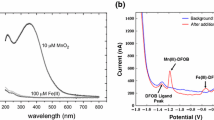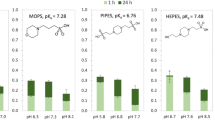Abstract
Given their environmental abundances, it has been long hypothesized that geochemical interactions between reactive forms of manganese and nitrogen may play important roles in the cycling of these elements. Indeed, recent studies have begun shedding light on the possible role of soluble, ligand-bound Mn(III) in promoting abiotic transformations under environmentally relevant conditions. Here, using the kinetic data of Karolewski et al. (Geochim Cosmochim Acta 293:365–378, 2021), we provide the chemical mechanism for the abiotic oxidation of nitrite (NO2−) by Mn(III)-pyrophosphate, MnIIIPP, to form nitrate (NO3−). Nitrous acid (HNO2), not NO2−, is the reductant in the reaction, based on thermodynamic and kinetic considerations. As soluble Mn(III) complexes react in a one-electron transfer reaction, two one-electron transfer steps must occur. In step one, HNO2 is first oxidized to nitrogen dioxide, ·NO2, a free radical via a hydrogen atom transfer (HAT) reaction. We show that this inner sphere reaction process is the rate-limiting step in the reaction sequence. In step two, ·NO2 reacts with a second MnIIIPP complex to form the nitronium ion (NO2+), which is isoelectronic with CO2. Unlike the poor electron-accepting capability of CO2, NO2+ is an excellent electron acceptor for both OH− and H2O, so NO2+ reacts quickly with water to form the end-product NO3− (step 3 in the reaction sequence). Thus, water provides the O atom in this nitrification reaction in accordance with the O-isotope data. This work provides mechanistic perspective on a potentially important interaction between Mn and nitrogen species, thereby offering a framework in which to interpret kinetic and isotopic data and to further investigate the relevance of this reaction under environmental conditions.




Similar content being viewed by others
References
Anschutz P, Sundby B, Lefrancois L, Luther GW III, Mucci A (2000) Interactions between metal oxides and species of nitrogen and iodine in bioturbated marine sediments. Geochim Cosmochim Acta 64:2751–2763. https://doi.org/10.1016/S0016-7037(00)00400-2
Bach RD, Ayala PY, Schlegel HB (1996) A reassessment of the bond dissociation energies of peroxides. an ab initio study. J Amer Chem Soc 118:12758–12765. https://doi.org/10.1021/ja961838i
Buchwald C, Casciotti KL (2013) Isotopic ratios of nitrite as tracers of the sources and age of oceanic nitrite. Nat Geosci 6:309–313. https://doi.org/10.1038/ngeo1745
Casciotti KL (2009) Inverse kinetic isotope fractionation during bacterial nitrite oxidation. Geochim Cosmochim Acta 73:2061–2076. https://doi.org/10.1016/j.gca.2008.12.022
Casciotti KL (2016) Nitrite isotopes as tracers of marine N cycle processes. Philosl Trans A 374:20150295. https://doi.org/10.1098/20150295
Cavazos AR, Taillefert M, Tang Y, Glass JB (2018) Kinetics of nitrous oxide production from hydroxylamine oxidation by birnessite in seawater. Mar Chem 202:49–57. https://doi.org/10.1016/j.marchem.2018.03.002
Dellwig O, Leipe T, Marz C, Glockzin M, Pollehne F, Schnetger B, Yakushev E, Bottcher ME, Brumsack HJ (2010) A new particulate Mn–Fe–P-shuttle at the redoxcline of anoxic basins. Geochim Cosmochim Acta 74:7100–7115
Dellwig O, Schnetger B, Brumsack HJ, Grossart HP, Umlauf L (2012) Dissolved reactive manganese at pelagic redoxclines (part II): hydrodynamic conditions for accumulation. J Mar Systems 90(1):31–41. https://doi.org/10.1016/j.jmarsys.2011.08.007
Jannis H, Shurong L, Vereecken H, Brüggemann N 2015) Abiotic nitrous oxide production from hydroxylamine in soils and their dependence on soil properties. Soil Biology and Biochemistry 84:107–115. https://doi.org/10.1016/j.soilbio.2015.02.022
Herszage J, dos Santos AM (2003) Mechanism of hydrogen sulfide oxidation by manganese(IV) oxide in aqueous solutions. Langmuir 19:9684–9692
Hoener M, Bodi A, Hemberger P, Endres T, Kaspe T (2021) Threshold photoionization shows no sign of nitryl hydride in methane oxidation with nitric oxide. Phys Chem Chem Phys 23:1265–1272. https://doi.org/10.1039/d0cp04924g
Jones MR, Luther GW, Mucci A, Tebo BM (2019) Concentrations of reactive Mn(III)-L and MnO2 in estuarine and marine waters determined using spectrophotometry and the leuco base, leucoberbelin blue. Talanta 200:91–99. https://doi.org/10.1016/j.talanta.2019.03.026
Karolewski JS, Sutherland K, Hansel CM, Wankel SW (2021) An isotopic study of abiotic nitrite oxidation by ligand-bound manganese (III). Geochim Cosmochim Acta 293:365–378. https://doi.org/10.1016/j.gca.2020.11.004
Klewicki JK, Morgan JJ (1998) Kinetic behavior of Mn(III) complexes of pyrophosphate, EDTA, and citrate. Environ Sci Techmol 32:2916–2922. https://doi.org/10.1021/es980308e
Kostka J, Luther GW, Nealson KH (1995) Chemical and Biological reduction of Mn(III)-pyrophosphate complexes: potential importance of dissolved Mn(III) as an environmental oxidant. Geochim Cosmochim Acta 59:885–894. https://doi.org/10.1016/0016-7037(95)00007-0
Lin H, Taillefert M (2014) Key geochemical factors regulating Mn(IV)-catalyzed anaerobic nitrification in coastal sediments. Geochim Cosmochim Acta 133:17–33. https://doi.org/10.1016/j.gca.2014.01.025
Liu S, Berns A, Vereecken H, Wu D, Brüggemann N (2017) Interactive effects of MnO2, organic matter and pH on abiotic formation of N2O from hydroxylamine in artificial soil mixtures. Sci Rep 7:39590. https://doi.org/10.1038/srep39590
Luther GW III (2004) Kinetics of the reactions of water, hydroxide ion and sulfide species with CO2, OCS and CS2: frontier molecular orbital considerations. Aquat Geochem 10:81–97. https://doi.org/10.1023/B:AQUA.0000038957.18584.b0
Luther GW III (2005) Manganese(II) oxidation and Mn(IV) reduction in the environment—two one-electron transfer steps versus a single two-electron step. Geomicrobiol J 22:195-203. https://doi.org/10.1080/01490450590946022
Luther GW III (2010) The role of one- and two-electron transfer reactions in forming thermodynamically unstable intermediates as barriers in multi-electron redox reactions. Aquatic Geochem 16:395–420. https://doi.org/10.1007/s10498-009-9082-3
Luther GW III (2016) Inorganic chemistry for geochemistry and environmental sciences: fundamentals and applications. Wiley, Chichester
Luther GW III, Popp JI (2002) Kinetics of the abiotic reduction of polymeric manganese dioxide by nitrite: an anaerobic nitrification reaction. Aquat Geochem 8:15–36. https://doi.org/10.1023/A:1020325604920
Luther GW III, Sundby B, Lewis BL, Brendel PJ, Silverberg N (1997) Interactions of manganese with the nitrogen cycle: alternative pathways to dinitrogen. Geochim Cosmochim Acta 61:4043–4052. https://doi.org/10.1016/S0016-7037(97)00239-1
Luther GW III, Thibault de Chanvalon A, Oldham VE, Estes E, Tebo BM, Madison AS (2018) Reduction of manganese oxides: thermodynamic, kinetic and mechanistic considerations for one- versus two-electron transfer steps. Aquat Geochem 24:257–277. https://doi.org/10.1007/s10498-018-9342-1
Madison AS, Tebo BM, Mucci A, Sundby B, Luther GW III (2013) Abundant Mn(III) in porewaters is a major component of the sedimentary redox system. Science 341:875–878. https://doi.org/10.1126/science.1241396
Matocha CJ, Sparks DL, Amonette JE, Kukkadapu RK (2001) Kinetics and mechanism of birnessite reduction by catechol. Soil Sci Soc Am J 65:58–66. https://doi.org/10.2136/sssaj2001.65158x
Oldham VE, Owings SM, Jones M, Tebo BM, Luther GW III (2015) Evidence for the presence of strong Mn(III)-binding ligands in the water column of the Chesapeake Bay. Mar Chem 171:58–66. https://doi.org/10.1016/j.marchem.2015.02.008
Oldham VE, Jones M, Tebo BM, Luther GW III (2017a) Oxidative and reductive processes contributing to manganese cycling at oxic-anoxic interfaces. Mar Chem 195:122–128. https://doi.org/10.1016/j.marchem.2017.06.002
Oldham VE, Mucci A, Tebo BM, Luther GW III (2017b) Soluble Mn(III)-L complexes are ubiquitous in oxygenated waters and stabilized by humic ligands. Geochim Cosmochim Acta 199:238–246. https://doi.org/10.1016/j.gca.2016.11.043
Oldham VE, Miller MT, Jensen LT, Luther GW III (2017c) Revisiting Mn and Fe removal in humic rich estuaries. Geochim Cosmochim Acta 209:267–283. https://doi.org/10.1016/j.gca.2017.04.001
Owings SM, Luther GW III, Taillefert M (2019) Development of a rate law for arsenite oxidation by manganese oxides. Geochim Cosmochim Acta 250:251–267. https://doi.org/10.1016/j.gca.2019.02.003
Qian A, Zhang W, Shi C, Pan C, Giammar DE, Yuan S, Zhang H, Wang Z (2019) Geochemical stability of dissolved Mn(III) in the presence of pyrophosphate as a model ligand: complexation and disproportionation. Environ Sci Techmol 53:5768–5777. https://doi.org/10.1021/acs.est.9b00498
Siebecker MG, Madison AS, Luther GW III (2015) Reduction kinetics of polymeric (Soluble) manganese (IV) Oxide (MnO2) by ferrous iron (Fe2+). Aquat Geochem 21(2–4):143–158. https://doi.org/10.1007/s10498-015-9257-z
Stone AT, Morgan JJ (1984a) Reduction and dissolution of manganese (III) and manganese(IV) oxides byorganics. 1. Reaction Hydroquinone Environ Sci Technol 18:450–456
Stone AT, Morgan JJ (1984b) Reduction and dissolution of manganese (III) and manganese(IV) oxides by organics. 2. Survey of the reactivity of organics. Environ Sci Technol 18:617–624
Trouwborst RE, Clement BG, Tebo BM, Glazer B, Luther GW III (2006) Soluble Mn(III) in suboxic zones. Science 313:1955–1957. https://doi.org/10.1126/science.1132876
Watters JI, Kolthoff IM (1948) Potentiometric investigation of tripyrophosphatomanganic (III) acid. J Amer Chem Soc 70:2455–2460
Yakushev E, Pollehne F, Jost F, Kuznetsov I, Schneider B, Umlauf L (2007) Analysis of the water column oxic/anoxic interface in the Black and Baltic seas with a numerical model. Mar Chem 107:388–410. https://doi.org/10.1016/j.marchem.2007.06.003
Yao W, Millero FJ (1993) The rate of sulfide oxidation by δMnO2 in seawater. Geochim Cosmochim Acta 57:3359–3365. https://doi.org/10.1016/0016-7037(93)90544-7
Yao W, Millero FJ (1995) Oxidation of hydrogen sulfide by Mn(IV) and Fe(III) (hydr)oxides in seawater. In: Vairavamurthy V, Schoonen MAA, Eglinton TI, Luther GW, Manowitz B (eds) Geochemical transformations of sedimentary sulfur. American chemical society symposium series, Washington, pp 260–2799
Zhang X-M, Bordwell FG (1992) Homolytic bond dissociation energies of the benzylic C–H bonds in radical anions and radical cations derived from fluorenes, triphenylmethanes, and related compounds. J Am Chem Soc 114:9787–9792
Zhu-Barker X, Cavazos AR, Ostrom NE, Horwarth WR, Glass JB (2015) The importance of abiotic reactions for nitrous oxide production. Biogeochemistry 126:251–267. https://doi.org/10.1007/s10533-015-0166-4
Acknowledgements
This work was supported by NSF Geobiology and Low-Temperature Geochemistry grant EAR1826940 to SDW and CMH, by NASA Earth and Space Science Fellowship NNX15AR62H and Agouron Institute Geobiology Postdoctoral Fellowship to KMS, and by NSF Chemical Oceanography grant OCE-1558738 to GWL. All original rate and isotope data can be found at https://doi.org/10.1016/j.gca.2020.11.004. We thank the anonymous reviewers for their constructive comments.
Author information
Authors and Affiliations
Corresponding author
Ethics declarations
Ethical Approval
The authors declare that they have no known competing financial interests or personal relationships that could have appeared to influence the work reported in this paper.
Additional information
Publisher's Note
Springer Nature remains neutral with regard to jurisdictional claims in published maps and institutional affiliations.
Rights and permissions
About this article
Cite this article
Luther III, G.W., Karolewski, J.S., Sutherland, K.M. et al. The Abiotic Nitrite Oxidation by Ligand-Bound Manganese (III): The Chemical Mechanism. Aquat Geochem 27, 207–220 (2021). https://doi.org/10.1007/s10498-021-09396-0
Received:
Accepted:
Published:
Issue Date:
DOI: https://doi.org/10.1007/s10498-021-09396-0




